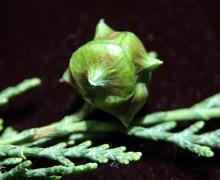Callitropsis nootkatensis
Common name:
Alaska-cedar
Yellow-cedar
Nootka Cypress
Nootka Falsecypress
Pronunciation:
cal-i-TROP-sis noot-ka-TEN-sis
Family:
Cupressaceae
Genus:
Synonyms:
Chamaecyparis nootkatensis
Xanthocyparis nootkatensis
Cupressus nootkaensis
Type:
Conifer
Native to (or naturalized in) Oregon:
Yes
- Conifer (but not a true cedar), evergreen tree, 60-90 ft (18-27 m) tall, slender conical, with drooping branches and flattened sprays. Leaves tightly appressed, dark bluish or grayish green, in 4 rows of similar size (3-6 mm long) (in alternating opposite pairs), an unpleasant, mildewy odor when bruised. Male flowers yellow and at the ends of branclets. Cones globose (round or spherical shape), 1 cm across, ripen in the second year, 4-6 scales, each with a hook-like, protruding, erect tip.
- Sun or partial shade. Prefers well-drained, moist soil.
- Hardy to USDA Zone 4 Native range is along the coast of Alaska and British Columbia, then in the Cascades of Washington and Oregon, just reaching northern California. It is one of the four native "cedars" (so-called) in Oregon. For a comparison of the four native "cedars" see Four "cedar" species native to Oregon
- Taxonomic changes: A new conifer discovered in northen Vietnam was described scientifically in 2002 (Farjon et al.). The tree was classified in a new genus in the family Cupressaceae as Xanthocyparis vietnamensis (Golden Vietnamese Cypress), its closest relative appears to be the Alaska-cedar. Apparently a good deal of evidence justifies placing both species in the same genus, and hence Alaska-cedar was renamed as Xanthocyparis nootkatensis. However, there is more to the story. Little et al. (Amer. J. Bot. 91:1872[2004]), while confirming the above relationship with further evidence, pointed out that an earlier nomenclatural combination in the genus Callitropsis existed, as Callitropsis nootkatensis (D.Don) Oerst., published in 1864 but overlooked or ignored by other subsequent authors. Thus Callitropsis would be the correct name for these species (Golden Vietnamese Cypress and Alaska-cedar) under the ICBN when treated in a distinct genus. The name Xanthocyparis was proposed for conservation, but until that is decided on, it is correctly classified in Callitropsis. It was thought that at decision would be made at 2011 International Botanical Congress, but for some reason the proposal did not make it to the committee which decides taxonomic conflicts (John Russell, 2011). However there is still more, Eckenwalder (2009) states that leaf chemistry and DNA sequences (Mao et al., 2012) show that Alaska-cedar belongs in Cupressus and hence Cupressus nootkatensis. Note: As of 2024, the World Flora Online (WFO Plant List) has the accepted name of this species as Callitropsis nootkatensis.
- "Although acceptance of the revised classification of this tree is widespread among botanists, inertia in the horticultural and forestry industries (both typically very slow to adopt the results of botanical research), mean the name Chamaecyparis nootkatensis is likely to continue being listed in many situations". (see: http://en.wikipedia.org/wiki/Cupressus_nootkatensis)
- Leaves similar to Western Red-cedar (Thuja plicata), but the 4-rows (alternating opposite pairs) of scale-leaves are of similar size, whereas in Western Red-cedar the 2 opposite pairs have a dissimilar appearance (not folded and folded). When branchlets of Alaska-cedar are stroked away from the tip, they feel prickly, those of Western Red-cedar do not. Leaves of Western Red-cedar have a pleasing odor when crushed, not the mildewy or raw potato of Alaska-cedar (Pojar and MacKinnon, 1994).
- Callitropsis nootkatensis (Alaska-cedar) is also often confused with Chamaecyparis lawsoniana (Port Orford Cedar, Lawsons Falsecypress). Click here for a table of distinguishing characteristics.
-
Several cultivars available, including:
- ‘Aurea’ - foliage bright yellow, slow growing
- ‘Pendula’ - strongly weeping form with branchlets hanging vertical
- 'Strict Weeping' - extremely narrow, foliage hanging down
- ‘Variegata’ - white to creamy-white variegation
- nootkatensis: nootka: after Nootka Sound, Vancouver Island, (-ensis, "of or from"), where the tree was first described by Archibald Menzies. He served as naturalist and ship's surgeon under Captain George Vancouver in an expedition from 1791 to 1795, which included exploration and mapping of North America's northwestern Pacific Coast regions.
- Corvallis: large treee on the NW corner of 6th Street and Harrison Ave.
- Oregon State Univ. campus: northside of LaSells Stewart Center.
Click image to enlarge














